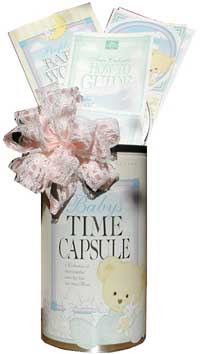精彩对白:The day Allison died in the fire, it's on the list, too, from a piece of paper that's been buried in the ground for five decades.
Time capsule 时间胶囊
A time capsule is a historic cache of goods and/or information, usually intended as a method of communication with people in the future. Time capsules are sometimes created and buried during celebrations such as a World Fair, cornerstone laying for a building, or at other events. The phrase "time capsule" has been in use since about 1939.
Time capsules can be classified into two types: intentional and unintentional. Intentional time capsules are placed on purpose and are usually intended to be opened at a particular future date. Unintentional time capsules are usually archaeological in nature. Discoveries of cultural significance are often found in standard archaeological digs as well as those from volcanic eruptions such as Pompeii and Vesuvius.

The concept of time capsules is not recent. The Epic of Gilgamesh, among humanity's earliest literary works, begins with instructions on how to find a box of copper inside a foundation stone in the great walls of Uruk - in the box is Gilgamesh's tale, written on a lapis tablet. There were other time capsules 5,000 years ago as vaults of artifacts hidden inside the walls of Mesopotamian cities[2]. Egyptian and other ancient tombs are effectively time capsules as well.
What is now thought of as a "time capsule" has more recent origins. In 1937, during preparations for the 1939 New York World's Fair, it was suggested to bury a "time bomb" for 5,000 years (until 6939)—the less inflammatory name of "time capsule" was suggested, and the name has stuck since. The 1939 New York World's Fair time capsule was created by Westinghouse as part of their exhibit, It was 90" long, with an interior diameter of 6.5 inches, and weighed 800 pounds. Westinghouse named the copper, chromium and silver alloy "Cupaloy", claiming it had the same strength as mild steel. It contained everyday items such as a spool of thread and doll, a Book of Record (description of the capsule and its creators), a vial of staple food crop seeds, a microscope and a 15-minute RKO Pathe Pictures newsreel. Microfilm spools condensed the contents of a Sears Roebuck catalog, dictionary, almanac, and other texts. This first modern time capsule was followed in 1965 by a second capsule at the same site, but 10 feet to the north of the original. Both capsules are buried 50 feet below Flushing Meadows Park, site of the Fair. Both the 1939 and 1965 Westinghouse Time Capsules are meant to be opened in 6939. More recently, in 1985, Westinghouse created a smaller, Plexiglas shell to be buried beneath the New York Marriott Marquis hotel, in the heart of New York's theater district. However, this time capsule was never put in place.
The Crypt of Civilization (1936) at Oglethorpe University, scheduled to be opened in 8113, is generally regarded to be the first successful implementation of a modern time capsule, although it was not called a time capsule at the time. George Edward Pendray is responsible for coining the term "time capsule."
During the socialist period in the USSR, many time capsules were buried with messages to the people who would live in the future communist society.
New Zealand developed a time capsule project called "Millennium Vault" for the turn of the 20th-century century. The project developers buried it beneath a pyramid.
Currently, four time capsules are "buried" in space. The two Pioneer Plaques and the two Voyager Golden Records have been attached to spacecraft for the possible benefit of spacefarers in the distant future. A fifth time capsule, the KEO satellite, will be launched in 2009 or 2010, carrying individual messages from Earth's inhabitants addressed to earthlings around the year 52,000, when KEO will return to Earth.
The International Time Capsule Society was created to maintain a global database of all existing time capsules.
Knowing 《先知》精讲之一参考答案
1. Who's jumping in?
2. But then there's the other side of the argument.
3. I think shit just happens.
4. Come on, you owe me for last time you skipped out on me.
考考你
1. 你知道自己在说些什么吗?
2. 我想找出纰漏,但是找不到。
3. 好吧,这很诡异,我同意。
4. 我觉得艾利森的死让你有些极端了。
精彩对白:The day Allison died in the fire, it's on the list, too, from a piece of paper that's been buried in the ground for five decades.
(中国日报网英语点津 编辑:Julie)
点击进入更多精彩电影回顾